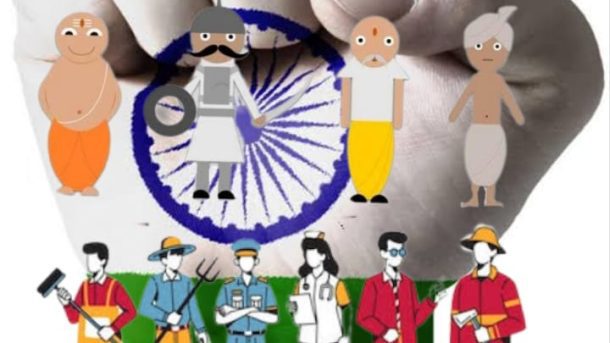In this article, I aim to provide an in-depth exploration of the Varna system in ancient India. Through discussions and arguments with my professors and friends, I have come to understand the many misconceptions and misunderstandings that exist about the Varna system, particularly in relation to its relationship with the caste system. In this article, I will draw upon my research and knowledge to provide a nuanced and accurate portrayal of the Varna system and its relevance to present-day society.
The concept of Varna is mentioned in various Vedic texts, such as the Rigveda, Yajurveda, and the Atharvaveda. One of the earliest references to the Varna system can be found in the Rigveda, where the four Varnas are described as arising from the body of the primal being, Purusha. The hymn describes the Brahmins as arising from the mouth of Purusha, the Kshatriyas from his arms, the Vaishyas from his thighs, and the Shudras from his feet. Exactly, just like how the body cannot function properly without all its parts working together, society cannot function properly without the contributions and cooperation of all its members. Each varna has its own unique set of skills and responsibilities, and together they form a harmonious and balanced society. It’s important to understand that the Varna system is not meant to be divisive or discriminatory, but rather it is meant to ensure that the different needs and functions of society are met by different groups of people, so that everyone can live in a good way.
The concept of varnas, or the ancient Indian social system, is often misunderstood and misrepresented in modern society. Many believe that varnas are a rigid, birth-based hierarchy, with certain castes being deemed superior or inferior. However, this is not the true nature of the varna system. Through discussions with my professors and friends, I have come to understand that varnas are a fluid and dynamic aspect of society, with individuals being placed in different varnas based on their qualities and role in society.
This article aims to explore the true nature of varnas and how they relate to the present-day class system in society.
The Four Varnas:The varna system is made up of four varnas: Brahmins, Kshatriyas, Vaishyas, and Shudras. Each varna has a specific role and purpose in society.

Brahmins are the scholars, teachers, and priests of society. They are responsible for the preservation and dissemination of knowledge and spiritual guidance. They are the intellectual class of society. In present-day society, professors, researchers, and religious leaders can be considered as Brahmins.
Kshatriyas are the warriors and rulers of society. They are responsible for the protection and administration of society. They are the ruling class of society. In present-day society, military personnel, politicians, and government officials can be considered as Kshatriyas.
Vaishyas are the merchants and traders of society. They are responsible for the economic growth and stability of society. They are the business class of society. In present-day society, business leaders, entrepreneurs, and financial experts can be considered as Vaishyas.
Shudras are the workers and laborers of society. They are responsible for the manual labor and service of society. They are the working class of society. In present-day society, factory workers, manual laborers, and government employees can be considered as Shudras.
It is also worth noting that many modern jobs and professions may span across multiple varnas and not all of them fit perfectly into one specific varna. For example, a lawyer may have some characteristics of a Brahmin and Kshatriya, in terms of knowledge and administrative skills. And it is important to note that the varnas are not fixed and can change based on an individual’s qualities and role in society. The varnas are not a hierarchy, but rather four aspects of society that are equally important for its overall growth and development.
Caste vs Varna System
It is important to note that the varna system should not be confused with the caste system. The caste system is a rigid, birth-based system, in which individuals are confined to a specific caste for their entire lives. The varna system, on the other hand, is a fluid and dynamic system, in which individuals can move between varnas based on their qualities and role in society.
Foreign scholars have often misunderstood and misrepresented the varna system in their writings. They have portrayed it as a rigid, birth-based hierarchy, with certain castes being deemed superior or inferior. This misunderstanding of the varna system has led to a distorted understanding of Indian history and society. It is unfortunate that the foreign scholars who wrote about the Indian history, misunderstood the varna system and wrote it as a rigid and birth-based hierarchy. This false understanding of the varna system has been perpetuated and believed by many, even in present day India.

In conclusion, it is clear that the Varna system as outlined in ancient Indian texts is a dynamic and fluid system, based on the qualities and actions of individuals rather than their birth. It is important to note that the Varna system should not be confused with the later caste system, which was rigid and based on birth. The misunderstanding of the Varna system by foreign scholars has led to a distorted understanding of Indian history and society. We must strive to understand the true nature of the Varna system and reject the misguided interpretations that have been passed down through history. By understanding and embracing the Varna system, we can create a harmonious and just society where all individuals have the opportunity to fulfill their potential and attain spiritual liberation.





